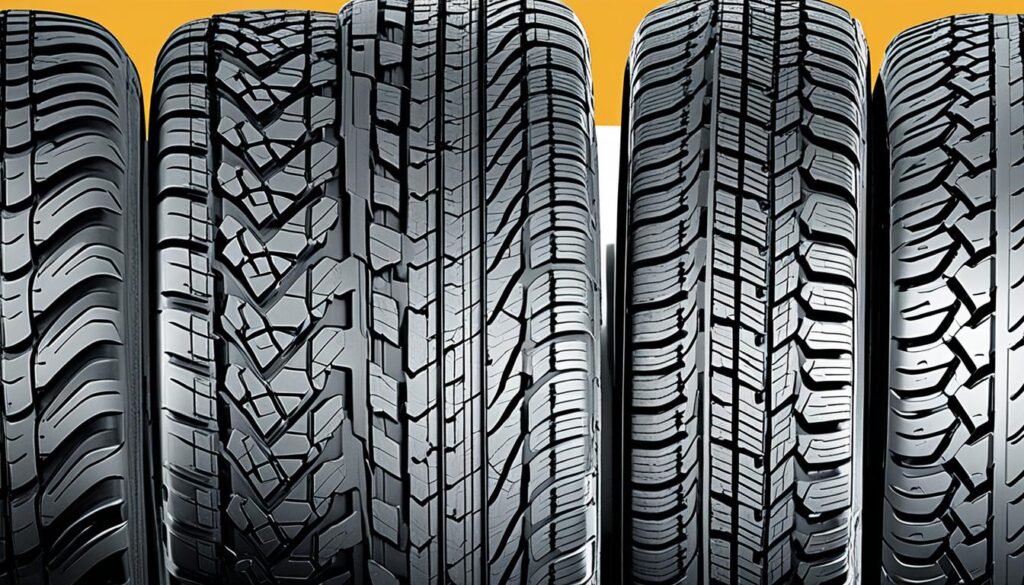As an Amazon Associate, I earn from qualifying purchases
When it comes to choosing the right tires for your vehicle, understanding the differences between options is essential. In this article, we will explore the key differences between 265 and 285 tires and how they can impact your vehicle’s performance.
The main difference between these two tire sizes lies in their width. 265 tires measure 265 millimeters, while 285 tires measure 285 millimeters. Although both sizes are wider than standard tires, there are distinct variations in various categories.
265 tires offer several advantages, including better traction in snow, slush, and wet conditions. Their narrower width increases the pressure per square inch on the road surface, providing improved grip and safety in adverse weather. Additionally, 265 tires contribute to better fuel economy due to their lower rolling resistance and reduced wind resistance. They are also more affordable and provide a comfortable and quiet ride.
On the other hand, 285 tires excel in areas such as handling, dry traction, weight distribution, stability, and load capacity. With their wider width, these tires provide better grip during cornering and high-speed maneuvers, ensuring enhanced stability and control. They also offer superior dry traction, thanks to their larger contact patch with the road surface, making them suitable for performance-oriented driving.
When deciding between 265 and 285 tires, it’s important to consider your preferences and the specific needs of your vehicle. Factors such as weather conditions, driving style, and load-carrying requirements will help determine which tire size is best for you.
Key Takeaways:
- 265 tires are narrower and provide better snow, slush, and water traction.
- 285 tires are wider and offer improved handling, dry traction, and load capacity.
- 265 tires contribute to better fuel economy and are more affordable.
- The choice between 265 and 285 tires depends on individual preferences and vehicle requirements.
- Consulting with a tire expert or referring to the vehicle manufacturer’s recommendations is recommended for selecting the most suitable tire size.
Advantages of 265 Tires
When considering tire options, it’s important to understand the advantages of 265 tires. These tires offer several benefits that make them a popular choice among drivers.
- Better traction in adverse weather: With their narrower width, 265 tires provide improved traction in snowy, slushy, and wet conditions. The increased pressure per square inch on the road surface enhances grip, contributing to better safety when driving in challenging weather conditions.
- Enhanced fuel economy: 265 tires have lower rolling resistance and reduced wind resistance compared to wider tires, resulting in improved fuel efficiency. This is especially beneficial for drivers looking to save on fuel costs and reduce their environmental impact.
- Affordability: In terms of both manufacturing and market demand, 265 tires are generally more affordable compared to wider tire options. This makes them a cost-effective choice for budget-conscious drivers without compromising on performance or quality.
- Comfortable and quiet ride: The narrower profile of 265 tires allows for less contact with road imperfections, resulting in a smoother and more comfortable ride. Additionally, the reduced tread width contributes to a quieter driving experience, minimizing road noise and enhancing overall comfort.
Overall, the advantages of 265 tires, including improved traction in adverse weather, enhanced fuel economy, affordability, and a comfortable ride, make them a compelling choice for many drivers.
| Advantages of 265 Tires | |
|---|---|
| Better traction in adverse weather | ✔ |
| Enhanced fuel economy | ✔ |
| Affordability | ✔ |
| Comfortable and quiet ride | ✔ |
Expert Insight:
“265 tires offer a balanced combination of traction, fuel efficiency, affordability, and comfort. They are a reliable option for everyday driving and provide a great value for money.” – Sarah Johnson, Tire Expert
With their narrower width, 265 tires provide better traction in adverse weather conditions, improved fuel economy, affordability, and a more comfortable and quieter ride compared to wider tire options. These advantages make them an attractive choice for drivers seeking reliable performance and value.
Advantages of 285 Tires
When it comes to enhanced performance, 285 tires offer several advantages that make them a top choice for drivers. With their wider width, these tires provide better handling and stability, especially during cornering and high-speed maneuvers. The increased contact patch with the road surface ensures superior dry traction, allowing for improved control and responsiveness.
One of the key benefits of 285 tires is improved weight distribution and stability. The wider profile helps distribute the vehicle’s weight more evenly, leading to better braking performance and enhanced stability on the road. This attribute is particularly beneficial for heavy-duty vehicles, trucks, and SUVs that frequently carry heavy loads or tow trailers.

Additionally, 285 tires excel in hauling and towing applications, thanks to their higher load capacity. Their robust construction and wider tread allow for better load-bearing capabilities, making them ideal for vehicles involved in regular transport of goods or equipment.
Overall, the advantages of 285 tires can significantly enhance the performance of your vehicle, providing better handling, stability, dry traction, and load capacity. If you prioritize performance and require a tire that can withstand heavy loads, 285 tires are an excellent choice.
Interchangeability and Compatibility
Many drivers often wonder about the interchangeability of tire sizes, such as 265, 275, and 285. When replacing tires, it’s crucial to consider compatibility and understand the implications of swapping different tire sizes.
Generally, it is recommended to change all four tires simultaneously to maintain balance and optimize performance. However, if you are replacing all four tires, there is some flexibility in swapping certain sizes.
If you are considering a 265 vs 275 tire comparison, it is possible to use 265 tires instead of 275 tires as long as the aspect ratio and rim diameter remain the same. Similarly, if you are comparing 275 vs 285 tires, you can replace 275 tires with 285 tires, again ensuring that the aspect ratio and rim diameter are compatible.
However, it’s important to note that mixing different tire sizes on the same axle should be avoided. Incompatibility in tire sizes can impact wheel traction distribution and potentially compromise the safety and performance of your vehicle.
The Importance of Aspect Ratio and Rim Diameter
When considering tire compatibility and interchangeability, two key factors to pay attention to are the aspect ratio and rim diameter.
The aspect ratio refers to the ratio of the tire’s sidewall height to its width. It is indicated as a percentage, such as 60 or 70. The aspect ratio plays a vital role in maintaining the overall diameter of the tire when switching between sizes. Keeping the aspect ratio consistent ensures that the overall circumference of the tire remains the same, minimizing any negative effects on speedometer accuracy and maintaining consistent handling characteristics.
The rim diameter, on the other hand, refers to the diameter of the wheel on which the tire is mounted. It is critical to ensure that the tire’s rim diameter matches the wheel’s rim diameter for a proper and secure fit.

Table: Tire Size Compatibility Guide
| Original Tire Size | Compatible Replacement Tire Sizes |
|---|---|
| 265/75R16 | 275/75R16, 265/70R16 |
| 275/70R17 | 285/70R17, 275/65R17 |
| 285/65R18 | 295/65R18, 285/60R18 |
| 265/50R20 | 275/50R20, 265/55R20 |
Table: Tire Size Compatibility Guide
Consulting with a professional tire expert or referring to your vehicle manufacturer’s recommendations is always a good idea to ensure the best compatibility and performance for your specific vehicle.
Conclusion
In conclusion, the comparison between 265 and 285 tires reveals significant differences in performance characteristics, despite their similarities in width and purpose.
When it comes to 265 tires, they offer advantages in terms of snow and wet traction, fuel economy, affordability, and ride comfort. Their narrower width allows for better pressure distribution on the road surface, resulting in improved traction and safety in adverse weather conditions. Additionally, 265 tires contribute to better fuel efficiency and provide a more comfortable and quieter ride.
On the other hand, 285 tires excel in areas such as handling, dry traction, weight distribution, stability, and load capacity. Their wider width allows for a larger contact patch with the road, enhancing stability and performance during cornering and high-speed maneuvers. They are particularly suitable for trucks and vehicles that frequently carry heavy loads.
Ultimately, the choice between 265 and 285 tires depends on individual preferences, driving conditions, and the specific needs of the vehicle. It is important to consider factors such as weather conditions, driving style, and load-carrying requirements when making a decision. Consulting with a professional tire expert or referring to the vehicle manufacturer’s recommendations can help you determine the most suitable tire size for your specific vehicle.
FAQ
What are the key differences between 265 and 285 tires?
The key difference is the width, with 265 tires measuring 265 millimeters and 285 tires measuring 285 millimeters. 265 tires offer better snow, slush, and water traction, improved fuel economy, affordability, and a more comfortable and quiet ride. 285 tires excel in handling, dry traction, weight distribution, stability, and load capacity.
What are the advantages of 265 tires?
265 tires offer better traction in snowy, slushy, and wet conditions, improved fuel economy, affordability, and a more comfortable and quiet ride.
What are the advantages of 285 tires?
285 tires provide better handling and stability, superior dry traction, improved weight distribution and stability, and higher load capacity.
Can I interchange tire sizes like 265, 275, and 285?
While some interchanges are possible, it’s generally recommended to change all four tires simultaneously to maintain balance. If all four tires are being replaced, 265 tires can be used instead of 275 tires, and 275 tires can be used instead of 285 tires, as long as the aspect ratio and rim diameter remain the same. However, mixing different tire sizes on the same axle should be avoided.
Is there a conclusion on 265 vs 285 tires?
The choice between 265 and 285 tires depends on individual preferences, driving conditions, and the specific needs of the vehicle. Factors such as weather conditions, driving style, and load-carrying requirements should be considered. Consult with a professional tire expert or refer to the vehicle manufacturer’s recommendations for the most suitable tire size for your specific vehicle.
